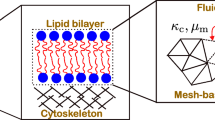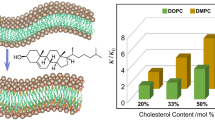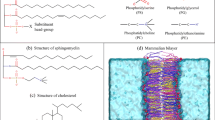Abstract
While conformational flexibility of proteins is widely recognized as one of their functionally crucial features and enjoys proper attention for this reason, their elastic properties are rarely discussed. In ion channel studies, where the voltage-induced or ligand-induced conformational transitions, gating, are the leading topic of research, the elastic structural deformation by the applied electric field has never been addressed at all. Here we examine elasticity using a model channel of known crystal structure—Staphylococcus aureus α-hemolysin. Working with single channels reconstituted into planar lipid bilayers, we first show that their ionic conductance is asymmetric with voltage even at the highest salt concentration used where the static charges in the channel interior are maximally shielded. Second, choosing 18-crown-6 as a molecular probe whose size is close to the size of the narrowest part of the α-hemolysin pore, we analyze the blockage of the channel by the crown/K+ complex. Analysis of the blockage within the framework of the Woodhull model in its generalized form demonstrates that the model is able to correctly describe the crown effect only if the parameters of the model are considered to be voltage-dependent. Specifically, one has to include either a voltage-dependent barrier for crown release to the cis side of the channel or voltage-dependent interactions between the binding site and the crown. We suggest that the voltage sensitivity of both the ionic conductance of the channel seen at the highest salt concentration and its blockage by the crown reflects a field-induced deformation of the pore.








Similar content being viewed by others
References
Alcaraz A, Nestorovich EM, Aguilella-Arzo M, Aguilella VM, Bezrukov SM (2004) Salting out the ionic selectivity of a wide channel: the asymmetry of OmpF. Biophys J 87:943–957
Allen MP, Tildesley DJ (1989) Computer simulation of liquids. Oxford Science Publication, Oxford
Barry PH, Lynch JW (1991) Liquid junction potentials and small cell effects in patch-clamp analysis. J Membr Biol 121:101–117
Bezrukov SM, Krasilnikov OV, Yuldasheva LN, Berezhkovskii AM, Rodrigues CG (2004) Field-dependent effect of crown ether (18-crown-6) on ionic conductance of α-Hemolysin channels. Biophys J 87:3162–3171
Felder CE, Botti SA, Lifson S, Silman I, Sussman JL (1997) External and internal electrostatic potentials of cholinesterase models. J Mol Graph Model 15:318–327
Gouaux JE, Braha O, Hobaugh MR, Song L, Cheley S, Shustak C, Bayley H (1994) Subunit stoichiometry of staphylococcal alpha-hemolysin in crystals and on membranes: a heptameric transmembrane pore. Proc Natl Acad Sci USA 91:12828–12831
Gray GS, Kehoe M (1984) Primary sequence of the alpha-toxin gene from Staphylococcus aureus Wood 46. Infect Immun 46:615–618
Gu LQ, Cheley S, Bayley H (2003) Electroosmotic enhancement of the binding of a neutral molecule to a transmembrane pore. Proc Natl Acad Sci USA 100:15498–15503
Guex N, Peitsch MC (1997) SWISS-MODEL and the Swiss-PdbViewer: an environment for comparative protein modeling. Electrophoresis 18(15):2714–2723
Hille B (1992) Ionic channels of excitable membranes. Sinauer Associates Inc, Sunderland, MA
Howorka S, Bayley H (2002) Probing distance and electrical potential within a protein pore with tethered DNA. Biophys J 83(6):3202–3210
Krasilnikov OV, Ternovsky VI, Musaev YuM, Tashmukhamedov BA (1980) Influence of staphylotoxin on conductance of bilayer phospholipid membranes. Doklady AN UzSSR 7:66–68
Krasilnikov OV, Ternovsky VI, Tashmukhamedov BA (1981) Properties of ion channels induced by alpha-staphylotoxin in bilayer lipid membranes. Biofizika 26:271–276
Krasilnikov OV, Merzlyak PG, Yuldasheva LN, Rodrigues CG, Bhakdi S, Valeva A (2000) Electrophysiological evidence for heptameric stoichiometry of ion channels formed by Staphylococcus aureus alpha-toxin in planar lipid bilayers. Mol Microbiol 37:1372–1378
Merzlyak PG, Yuldasheva LN, Rodrigues CG, Carneiro CMM, Krasilnikov OV, Bezrukov SM (1999) Polymeric non-electrolytes to probe pore geometry: application to the alpha-toxin transmembrane channel. Biophys J 77:3023–3033
Montal M, Mueller P (1972) Formation of bimolecular membranes from lipid monolayers and a study of their electrical properties. Proc Natl Acad Sci USA 69:3561–3566
Movileanu L, Cheley S, Howorka S, Braha O, Bayley H (2001) Location of a constriction in the lumen of a transmembrane pore by targeted covalent attachment of polymer molecules. J Gen Physiol 117:239–252
Noskov SYu, Im W, Roux B (2004) Ion permeation through the α-Hemolysin channel: theoretical studies based on brownian dynamics and poisson-nernst-plank electrodiffusion theory. Biophys J 87:2299–2309
Ozutsumi K, Ishiguro SI (1992) A precise calorimetric study of 18-crown-6 complexes with sodium, potassium, rubidium, cesium, and ammonium ions in aqueous solution. Bull Chem Soc Jpn 65:1173–1175
Parsegian VA (2004) van der Waals forces. Cambridge University Press (in press)
Parsegian VA, Weiss GH (1974) Electrodynamic interactions between curved parallel surfaces. J Phys Chem 60:5080–5085
Pedersen CJ (1967) Cyclic polyethers and their complexes with metal salts. J Am Chem Soc 89:7017–7036
Pedersen CJ (1968) Ionic complexes of macrocyclic polyethers. Fed Proc 27:1305–1309
Pedersen CJ (1988) The discovery of crown ethers. Science 241:536–540
Rounaghi G, Eshaghi Z, Ghiamati E (1977) Thermodynamic study of complex formation between 18-crown-6 and potassium ion in some binary non-aqueous solvents using a conductometric method. Talanta 44:275–282
Song L, Hobaugh MR, Shustak C, Cheley S, Bayley H, Gouaux JE (1996) Structure of staphylococcal α-hemolysin, a heptameric transmembrane pore. Science 274:1859–1866
Tikhonov DB, Magazanik LG (1998) Voltage dependence of open channel blockage: onset and offset rates. J Membr Biol 161:1–8
Woodhull AN (1973) Ionic blockage of sodium channels in nerve. J Gen Physiol 61:687–708
Zaccai G (2000) How soft is a protein? A protein dynamics force constant measured by neutron scattering. Science 288:1604–1607
Acknowledgements
We are grateful to Genrih N. Berestovsky, Alexander M. Berezkovskii, Daniel Harries, and V. Adrian Parsegian for fruitful discussions. Our special thanks are due to Sergey M. Bezrukov, who made many useful suggestions and also helped with the writing of the manuscript. This study was supported by Conselho National de Desenvolvimento Cientifico e Tecnologico (Brazil).
Author information
Authors and Affiliations
Corresponding author
Note added in proof
Note added in proof
After this manuscript was accepted, Aksimentiev & Schulten published an article (Aksimentiev A. and Schulten K. Imaging a-Hemolysin with Molecular Dynamics: Ionic Conductance, Osmotic Permeability, and the Electrostatic Potential Map. Biophys. J. 88 June 2005 3745–3761) showing that residues, which are located at the outer surface of the beta-barrel could change their orientations without any large structural changes of the channel when altering the value of the transmembrane potential. Moreover, in the personal communication they revealed that switching the transmembrane potential from +120 to −120 mV (the sign is assigned to the cis opening of the channel) directs Lys147, on average, upward (to the cis vestibule of the channel), increasing the radius of the pore constriction by about 0.8 Å. Thus there is remarkable agreement between that theoretical prediction and our experimental data indicating the elastic deformation of the alpha-hemolysin channel under the electric field influence.
Rights and permissions
About this article
Cite this article
Krasilnikov, O.V., Merzlyak, P.G., Yuldasheva, L.N. et al. Protein electrostriction: a possibility of elastic deformation of the α-hemolysin channel by the applied field. Eur Biophys J 34, 997–1006 (2005). https://doi.org/10.1007/s00249-005-0485-9
Received:
Revised:
Accepted:
Published:
Issue Date:
DOI: https://doi.org/10.1007/s00249-005-0485-9




